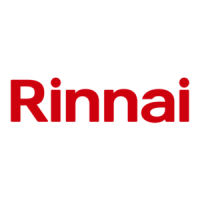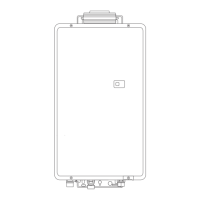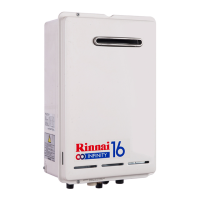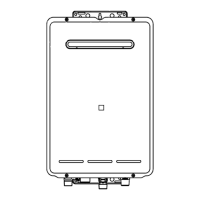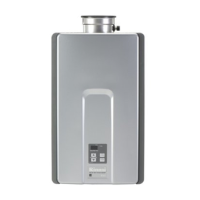Do you have a question about the Rinnai REU-V1616WF and is the answer not in the manual?
Identifies the product type.
General Warnings and Precautions
Outlines the main advantages and operational characteristics of the hot water system.
Details the various sensors and safety mechanisms integrated into the unit.
Provides data related to the gas combustion process and requirements.
Explains how to calculate water flow rates using a given formula and parameters.
Illustrates the relationship between water pressure and flow volume.
Specifies the necessary ventilation for safe and efficient appliance operation.
Details the approved flueing systems and installation rules.
Describes direct flueing configurations with wall terminals.
Outlines vertical flueing options with roof terminals.
Highlights crucial points for correct and safe flue system installation.
Details methods for extending direct flueing configurations.
Explains the function and drainage requirements for condensate.
Describes the standard remote controller model and its capabilities.
Provides instructions on where and how to position the remote controllers.
Details the connection and cabling requirements for remote controllers.
Step-by-step guide for connecting remote control cables to the appliance.
Instructions for wiring up to three remote controllers.
Illustrates the step-by-step process of normal combustion operation.
Depicts flow charts for mis-ignition and flame failure events.
Explains the ignition and heating process of the hot water system.
Details how the system manages water temperature and flow rates.
Describes the steps taken when the hot water tap is turned off.
Explains the role of the PCB in controlling appliance functions.
Details how gas flow is regulated for consistent water temperature.
Describes how water flow is detected and managed by the unit.
Explains the air supply control and the combustion chamber components.
Provides step-by-step instructions for installing the anti-frost kit.
Shows timing diagrams for normal combustion cycles.
Illustrates timing for ignition errors and airflow issues.
Explains the purpose of various dip switch settings on the appliance.
Details dip switch configurations for gas type and pressure.
Describes dip switch settings for temperature control with/without controllers.
Guides users on how to diagnose and rectify appliance faults using various resources.
Procedures for checking the combustion fan motor and its sensor.
Steps for checking the sparker unit and ignition plug.
Procedures for testing the main solenoid valve circuit.
Steps for diagnosing the Solenoid Valve 1 circuit.
Procedures for testing the Solenoid Valve 2 circuit.
Steps for checking the modulating valve and its voltage.
Procedures for checking the flame rod for proper function and resistance.
Instructions for verifying the earth lead connection and integrity.
Procedures for testing the thermal fuse and overheat switch circuits.
Steps for checking the water flow sensor voltage and resistance.
Procedures for checking the water flow servo circuit voltages.
Steps for checking the hot water outlet thermistor resistance.
Procedures for checking the surge protector and electrical fuse.
Steps for testing the transformer and remote control system.
Instructions on how to access and view maintenance information and codes.
Steps to display the stored error codes and fault sequences.
Detailed steps for setting gas pressure for different combustion modes.
Instructions for converting the appliance between gas types.
Lists component removal procedures with corresponding page numbers for detailed instructions.
Step-by-step guide to remove the front panel of the appliance.
Instructions for safely disconnecting and removing the Printed Circuit Board.
Steps for removing the EMC sub board.
Procedures for removing the appliance's transformer.
Steps for removing the igniter component.
Guide for removing the manifold and burner assembly.
Detailed steps for removing the gas control unit and its associated parts.
Procedures for removing the flame rod and ignition plug.
Steps for removing the outgoing heater thermistor.
Instructions for removing the water flow servo and its sensor.
Steps for removing the combustion fan motor.
Detailed steps for removing the heat exchanger assembly.
Instructions for removing and replacing the thermal fuse.
Identifies the product type.
General Warnings and Precautions
Outlines the main advantages and operational characteristics of the hot water system.
Details the various sensors and safety mechanisms integrated into the unit.
Provides data related to the gas combustion process and requirements.
Explains how to calculate water flow rates using a given formula and parameters.
Illustrates the relationship between water pressure and flow volume.
Specifies the necessary ventilation for safe and efficient appliance operation.
Details the approved flueing systems and installation rules.
Describes direct flueing configurations with wall terminals.
Outlines vertical flueing options with roof terminals.
Highlights crucial points for correct and safe flue system installation.
Details methods for extending direct flueing configurations.
Explains the function and drainage requirements for condensate.
Describes the standard remote controller model and its capabilities.
Provides instructions on where and how to position the remote controllers.
Details the connection and cabling requirements for remote controllers.
Step-by-step guide for connecting remote control cables to the appliance.
Instructions for wiring up to three remote controllers.
Illustrates the step-by-step process of normal combustion operation.
Depicts flow charts for mis-ignition and flame failure events.
Explains the ignition and heating process of the hot water system.
Details how the system manages water temperature and flow rates.
Describes the steps taken when the hot water tap is turned off.
Explains the role of the PCB in controlling appliance functions.
Details how gas flow is regulated for consistent water temperature.
Describes how water flow is detected and managed by the unit.
Explains the air supply control and the combustion chamber components.
Provides step-by-step instructions for installing the anti-frost kit.
Shows timing diagrams for normal combustion cycles.
Illustrates timing for ignition errors and airflow issues.
Explains the purpose of various dip switch settings on the appliance.
Details dip switch configurations for gas type and pressure.
Describes dip switch settings for temperature control with/without controllers.
Guides users on how to diagnose and rectify appliance faults using various resources.
Procedures for checking the combustion fan motor and its sensor.
Steps for checking the sparker unit and ignition plug.
Procedures for testing the main solenoid valve circuit.
Steps for diagnosing the Solenoid Valve 1 circuit.
Procedures for testing the Solenoid Valve 2 circuit.
Steps for checking the modulating valve and its voltage.
Procedures for checking the flame rod for proper function and resistance.
Instructions for verifying the earth lead connection and integrity.
Procedures for testing the thermal fuse and overheat switch circuits.
Steps for checking the water flow sensor voltage and resistance.
Procedures for checking the water flow servo circuit voltages.
Steps for checking the hot water outlet thermistor resistance.
Procedures for checking the surge protector and electrical fuse.
Steps for testing the transformer and remote control system.
Instructions on how to access and view maintenance information and codes.
Steps to display the stored error codes and fault sequences.
Detailed steps for setting gas pressure for different combustion modes.
Instructions for converting the appliance between gas types.
Lists component removal procedures with corresponding page numbers for detailed instructions.
Step-by-step guide to remove the front panel of the appliance.
Instructions for safely disconnecting and removing the Printed Circuit Board.
Steps for removing the EMC sub board.
Procedures for removing the appliance's transformer.
Steps for removing the igniter component.
Guide for removing the manifold and burner assembly.
Detailed steps for removing the gas control unit and its associated parts.
Procedures for removing the flame rod and ignition plug.
Steps for removing the outgoing heater thermistor.
Instructions for removing the water flow servo and its sensor.
Steps for removing the combustion fan motor.
Detailed steps for removing the heat exchanger assembly.
Instructions for removing and replacing the thermal fuse.
| Brand | Rinnai |
|---|---|
| Model | REU-V1616WF |
| Category | Water Heater |
| Language | English |
